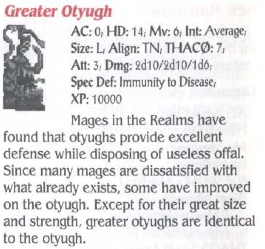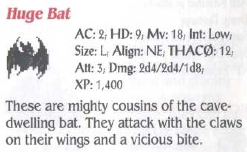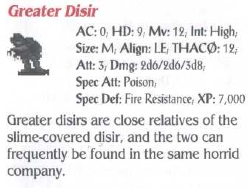Part 48: Queenly Gaps 1: Final Magic, More Monsters, and High Levels
Queenly Gaps 1: Final Magic, More Monsters, and High LevelsThis is probably a bit overdue, but now that we're past the introductory phases of Dark Queen of Krynn, it's probably worth talking a bit more about game mechanics and some of the things being introduced. First off, our characters are getting more powerful so it might be a good time to talk about...
High Level Characters
Now that our heroes are getting up there in levels, we're starting to enter into what most people refer to as the Epic tier. That doesn't really mean anything in this edition, however, as the idea of Epic levels wasn't really introduced until 3rd Edition. What happened instead was that Gary Gygax and his compatriots introduced supplemental material in the form of expansions to the regular sets for people who wanted to play that kind of campaign. It's worth noting that generally the assumption was that your characters probably weren't going to get to an obscenely high level in regular play. So, what kind of things start happening at higher levels?
HP Gains
After a certain point in a character's progression, you stop getting additional hit dice and start getting static bonuses to HP. It varies a bit from class to class, but in general you're looking at between 8th and 11th level. After passing that point, each class has a progression of +1, +2, or +3 HP per level. It breaks down kind of like this in the Krynn Goldbox Series:
Clerics top out at 9d8 HP plus Con bonuses (max +2 HP per hit dice for all non-fighter classes) when they reach level 9, then gain 1 HP per level afterward.
Mages max out at 11d4 plus Con at level 11, and then gain 1 HP per level.
Thieves max out at 10d6 plus Con at level 10, and then gain 2 HP per level.
Paladins and Fighters get up to 9d10 plus Con (max +4 HP per hit dice for all fighter classes) at level 9, then gain 3 HP per level.
Rangers top out at 11d8 plus Con at level 10, then gain 2 HP per level.
Knights max out at 10d10 plus Con at level 9, then gain 2 HP per level.
Constitution doesn't factor into HP once you start getting static gains, so in some ways this kind of evens the playing field a bit. You can kind of see the effect in our current crop of heroes.
THAC0 and Saving Throws
THAC0 and Saving Throws top out at a different level for all classes. For THAC0 Priests improve by 2 points every 3 levels, Thieves by 1 every 2 levels, Fighters by 1 point every level, and Mages by one point every 3 levels. Both THAC0 and Saving Throws max out at around the same level for each class: it's level 19 for Priests, 21 for Rogues and Wizards, and 17 for Fighters. Interestingly enough, Fighters end up with the best average saves and thieves with the worst, which is somewhat contrary to the image of thieves as survivors. As you can see, for some of our characters this means that they've already gotten as good as they're going to get when it comes to avoiding magical mayhem.
Experience Levels
Once you stop gaining hit dice with each level, your experience points required also flatline. For most characters this ranges between 200,000 to 350,000 experience per level, with Red Robe Mages having the lowest requirement followed in order by Thieves, Clerics of Neutrality, Clerics of Good/Fighters/White Robed Mages, and the rest. Knights required 300,000, 350,000, and 500,000 respectively for each advancing order, but have a hard cap on how high you can go in a given order. Knights of the Crown and Sword cannot ever advance past 18th level, which is a considerable issue as experience points start piling up. The game also won't let you cheat the system by changing orders… instead of just popping you into the same level as Knight of your new order, it actually looks at your experience and adjust accordingly. A max level Knight of the Sword would lose 4 levels in becoming a Knight of the Rose
Spell Slots
Although you can continue gaining experience levels up to level 40 in DQK, each spell casting class has a certain point beyond which they won't get any more spell slots. Rangers stop the earliest at level 17, but Paladins and Knights don't have it much better and stop getting slots at level 20. Dedicated spell casters, such as priests and mages, keep getting new spell slots up until level 29.
That about wraps it up for higher level characters.
Hey, speaking of spells…
Final Magic
Dark Queen of Krynn adds a few new spells to earlier levels, and we've also gotten a few more options through leveling up. So, with no further ado...
Mage Spells
Reduce (1st Level) - Counterpart to Enlarge, does exactly what you'd expect and makes the enemy smaller and weaker. Naturally the enemies get a saving throw. Like all 1st level spells, available to everybody.
Cone of Cold (5th level) - Now available to learn through leveling up for Ishmael, along with Cloudkill. Does up to 15d6 cold damage in a line, but unlike lightning bolt this starts directly in front of the caster regardless of where you target in. In practice, this means you have to maneuver to make sure the space in front of your mage is clear when casting.
9th Level Spells
Meteor Swarm - Supposedly the biggest and most bad-ass spell in the magical arsenal, this spell sends 4 giant meteors heading in a direction of your choice where they explode at a designated point. Each explosion does 10d4 damage, for a total of 40-160 damage. It sounds pretty fantastic, but there's a couple of problems. First off, like Cone of Cold this spell doesn't discriminate and will happily hit your characters if they're in the way. Secondly, the explosions are in different directions from the target point and thus aren't likely to hit a given target more than 1 or 2 times.
Monster Summoning - In regular D&D this is an entire family of spells that gradually summon more and more powerful creatures. In DQK, we only get the top end of it. This is of somewhat limited utility, but will give you a Gorgon, Hydra, or similar creature. Considering how easily we tear through those, having one or two on our side isn't that much of a plus.
Power Word Kill - The premier anti-mage spell in the game, Power Word Kill will instantly kill any living target with less than 120 HP. No saving throw, either. If you've got less than 120 HP you're toast. Right now we've only run across one or two creatures with more HP than that, meaning that Ishmael now has the ability to kill just about anything instantly. The range is a bit short, however, so you might have to close the distance before using it.
Cleric Spells
Flame Strike (5th level) - Hey! We finally get an offensive option for our priests! This one does 6d8 damage to a single target, but hey, it's better than nothing. Enemies can save for half damage.
Blade Barrier (6th level) - Kind of a grown up version of Stinking Cloud, this spell produces four squares of circling blades and can be dropped on top of an enemy. If the enemy remains in the space or attempts to move through one of the spaces, they take 8d8 damage per space. It's pretty nasty, and a number of enemies love it.
Seventh Level Spells
Resurrection - Kind of like Raise Dead, except it works on Elves and restores all of a target's HP and doesn't cause any loss of Constitution. Probably the best option here, and now that we've got two characters who can cast it the chances of a full party wipe are much lower.
Restoration - Finally, we've gotten access to the spell that most of the temples in the game have offered to us for free since the beginning. This spell restores lost levels and the like that have been taken from us by undead enemies, with the major caveat that the spell does not work as part of the Fix command. If you want to use this spell, you need to keep track of what level your characters are at any given point. This can be harder than it seems, especially with characters across a wide range of level.
More Monsters
One of the nicer features in the Dark Queen Journal is that it actually gives you stat blocks for a few of the newly introduced enemies that were created especially for this game. We've by no means seen everything yet, but a few of of them are worth including.

These are some of the most common enemies we've seen thus far, and they're among the most lucrative in terms of experience. You can see that they've got a healthy number of attacks and damage, a decent THAC0, and are about as intelligent as an average human.

The Huge Bats we've seen around, on the other hand, aren't much to write home about. They're much less threatening and worth considerably less as well.

I vaguely recall seeing these guys back in the caves. They're a more interesting monster, since they're intelligent enough to be evil and yet still vaguely disgusting. Their fire resistance is an added obstacle.
Beholders
One of the more interesting and talked about enemies we've seen thus far in this game have been Beholders, which many games consider to be the stuff of nightmares. The most basic form of the Beholder is a large central eye with ten eyestalks, but numerous subspecies exist. Each of a standard beholder's eyes have a different function, including charm person, charm monster, sleep, telekinesis, flesh to stone, disintegrate, fear, slow, cause serious wounds, and a death ray. The central eye projects an anti-magic field in a 90 degree arc in front of the creature, which will also cut off the effects of the other eyes. In theory, then, a character who remains positioned directly in front of the central eye can't be targeted by any of the other spells.
The Monstrous Manual describes beholders as a hateful, aggressive and avaricious race that will attack anything that differs from themselves. People have correctly pointed out that something as small as a difference in hide color will cause two groups of beholders to become sworn enemies. Essentially, beholders hold their own particular form to be the ideal form for a beholder and anything else to be only fit for being destroyed. Beholder reproductive processes are still unknown, but they may reproduce through pathogenesis and create genetic replicas as a result.
There are something along the order of 20 different sub-species of Beholder, all with varying powers an abilities. Some of the more famous varieties include the Eye of the Deep that we've seen, Undead Beholders, and Beholder Mages. Undead Beholders are mindless undead that are controlled by powerful mages, while Beholder Mages are individuals who have blinded their central eye to clear the field so that they can channel a spell through one of their lesser eyes. There's far too many to list here, but essentially if you can imagine some kind of weird variation on a beholder they probably exist.